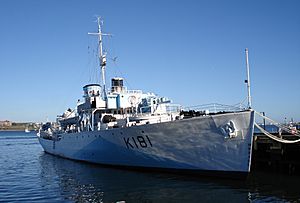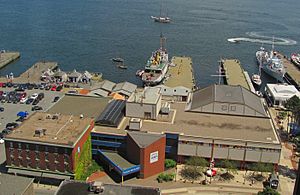HMCS Sackville facts for kids

HMCS Sackville in October 2006, moored behind the Maritime Museum of the Atlantic in Halifax, Nova Scotia, and restored to her 1944 condition.
|
|
Quick facts for kids History |
|
|---|---|
| Name | Sackville |
| Namesake | Sackville, New Brunswick |
| Builder | Saint John Dry Dock and Shipbuilding Company Ltd. |
| Laid down | 28 May 1940 |
| Launched | 15 May 1941 |
| Commissioned | 30 December 1941 |
| Decommissioned | 8 April 1946 |
| Refit | Thompson Bros. Machinery Co. Ltd., Liverpool, Nova Scotia, commenced 14 January 1943, machinery replacement, minesweeping gear removed, bridge wings extended to fit Oerlikon 20 mm AA Galveston, Texas, 28 February 1944 – 7 May 1944, forecastle extended, new bridge, hedgehog fitted, mast moved abaft of bridge, new boats, new electronics |
| Identification | Pennant number: K181 |
| Honours and awards |
Atlantic 1942-44 |
| Status | Museum ship, Halifax, Nova Scotia |
| General characteristics | |
| Class and type | Flower-class corvette |
| Displacement | 950 tons |
| Length | 62.5 m (205 ft 1 in) |
| Beam | 10 m (32 ft 10 in) |
| Draught | 3.5 m (11 ft 6 in) |
| Propulsion | Single shaft, 2 fire tube Scotch boilers, 1 4-cyl. triple expansion steam engine, 2,750 hp (2,050 kW) |
| Speed | 16 knots (30 km/h; 18 mph) |
| Complement | 85 |
| Armament |
|
| Notes | Now a museum ship owned by the Canadian Naval Memorial Trust, moored in season at the Maritime Museum of the Atlantic |
| Official name: HMCS Sackville National Historic Site of Canada | |
| Designated: | 1988 |
The HMCS Sackville is a special kind of warship called a Flower-class corvette. It served in the Royal Canadian Navy during World War II. After the war, it became a ship for scientific research. Today, the Sackville is a museum ship in Halifax, Nova Scotia. It's the very last Flower-class corvette left in the world!
Contents
A Ship Built for War
The Sackville was built to help protect ships during World War II. Its keel (the bottom part of the ship) was laid down in early 1940. This happened at the Saint John Shipbuilding and Drydock Company in Saint John, New Brunswick. It was the second Flower-class corvette ordered by the Royal Canadian Navy.
Launching and First Crew
The ship was officially launched on May 15, 1941. A special ceremony took place with the mayor and town council of Sackville, New Brunswick, the town the ship was named after. The Sackville joined the Royal Canadian Navy on December 30, 1941. Its first captain, Lieutenant W. R. Kirkland, had some trouble. He was replaced in April 1942 by Lieutenant-Commander Alan H. Easton and a new, well-trained crew.
Fighting in the Atlantic
In May 1942, the Sackville joined a group of ships called Escort Group C-3. Their job was to protect convoys (groups of merchant ships) crossing the Atlantic Ocean. These convoys were often attacked by German submarines, called U-boats.
In August 1942, the Sackville was part of a fierce battle while protecting Convoy ON 115. German U-boats attacked the convoy many times. The Sackville bravely fought back.
- On August 3, the Sackville found the German submarine U-43 on the surface. It attacked with depth charges, damaging the submarine badly. U-43 had to go back to France for repairs.
- The next day, Sackville attacked U-704. It then rescued two sailors from a damaged merchant ship.
- Hours later, Sackville used its radar to find U-552. It hit the submarine with a four-inch shell and a depth charge. U-552 was also badly damaged but managed to escape.
The Sackville's actions helped the convoy of 41 ships get away safely. Only two ships were lost.
Repairs and New Roles
The Sackville continued its escort duties until January 1943. It then went for a major repair in Liverpool, Nova Scotia. It returned to service in April and kept protecting convoys. In February 1944, it went for another big repair in Galveston, Texas.
After these repairs, the ship returned to Halifax in May 1944. It was then assigned to Escort Group C-2. However, a serious leak was found in one of its boilers. Because of this, the ship could no longer be used for escorting convoys.
The Sackville was then used for training. Soon after, it was changed into a "loop layer." This meant it would lay special cables across harbor entrances to detect enemy submarines. Its main gun was removed to make space for the cables. The Sackville stayed in this role until April 1946, when it was put into storage.
Life After the War
Most Flower-class corvettes were taken apart after World War II. But the Sackville was kept in storage.
Becoming a Research Ship
In 1952, the Sackville was brought back into service. It was changed into a research vessel for the Department of Fisheries and Oceans (Canada). All its weapons were removed. Its hull was painted black instead of its wartime camouflage. A laboratory was added in 1964, and the bridge was enclosed in 1968. The Sackville served as a research ship until December 1982.
A Floating Museum
The Sackville is now a museum ship. It is owned by the Canadian Naval Memorial Trust. In 1983, it was restored to look like it did in 1944 during the war.

Today, the Sackville spends its summers as a museum ship. It is docked next to the Maritime Museum of the Atlantic in Halifax, Nova Scotia. In winter, it is kept safely at the naval dockyard in CFB Halifax. Halifax was a very important port during the war for gathering convoys.
Hurricane Juan Incident
In September 2003, during Hurricane Juan, the Sackville broke free from its moorings. It hit a nearby sailing ship called the Larinda. The owners of the Larinda sued, but in 2011, the court decided that the Trust had done everything needed to secure the Sackville.
Remembering the Battle of the Atlantic
Every spring, the Sackville is towed to Point Pleasant Park in Halifax. This is for the "Commemoration of the Battle of the Atlantic" ceremony. This event remembers the important naval battles of World War II. The Sackville often hosts veterans of the Royal Canadian Navy. It has also been used for burials at sea for veterans' ashes. In 2018, the ship received about CAN$3.5 million in repairs.
Special Recognition
In 1988, the Sackville was named a National Historic Site of Canada. This was because it is the last Flower-class corvette still in existence.
On November 4, 1998, Canada Post released a special 45-cent stamp featuring the HMCS Sackville. It was part of a series about naval vessels.
Greyhound Film Connection
The HMCS Sackville was used as the model for a ship in the 2020 movie, Greyhound. The movie producers used 3D scans of the Sackville's outside to create a computer-generated version for the film.
Images for kids
-
Sackville as restored, moored alongside the Maritime Museum of the Atlantic in Halifax, Canada. The paint scheme on her hull is dazzle camouflage.
-
Sackville, Halifax Harbour, October 2006.
See also
- List of ships of the Canadian Navy
- List of museum ships
- Ship replica
- Ships preserved in museums








